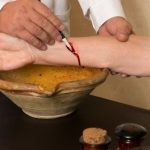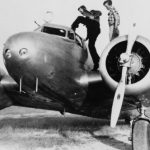 Music
Music  Music
Music  History
History 10 Less Than Jolly Events That Occurred on December 25
 Weird Stuff
Weird Stuff 10 Funny Ways That Researchers Overthink Christmas
 Politics
Politics 10 Political Scandals That Sent Crowds Into the Streets
 Weird Stuff
Weird Stuff Ten Bizarre Facts About The Doge Meme
 Our World
Our World 10 Ways Your Christmas Tree Is More Lit Than You Think
 Movies and TV
Movies and TV The 10 Coolest Stars to Set Sail on The Love Boat
 History
History 10 Things You Didn’t Know About the American National Anthem
 Technology
Technology Top 10 Everyday Tech Buzzwords That Hide a Darker Past
 Humans
Humans 10 Everyday Human Behaviors That Are Actually Survival Instincts
 Music
Music 10 Surprising Origin Stories of Your Favorite Holiday Songs
 History
History 10 Less Than Jolly Events That Occurred on December 25
 Weird Stuff
Weird Stuff 10 Funny Ways That Researchers Overthink Christmas
Who's Behind Listverse?

Jamie Frater
Head Editor
Jamie founded Listverse due to an insatiable desire to share fascinating, obscure, and bizarre facts. He has been a guest speaker on numerous national radio and television stations and is a five time published author.
More About Us Politics
Politics 10 Political Scandals That Sent Crowds Into the Streets
 Weird Stuff
Weird Stuff Ten Bizarre Facts About The Doge Meme
 Our World
Our World 10 Ways Your Christmas Tree Is More Lit Than You Think
 Movies and TV
Movies and TV The 10 Coolest Stars to Set Sail on The Love Boat
 History
History 10 Things You Didn’t Know About the American National Anthem
 Technology
Technology Top 10 Everyday Tech Buzzwords That Hide a Darker Past
 Humans
Humans 10 Everyday Human Behaviors That Are Actually Survival Instincts
10 Eccentric Habits of the Rich and Famous Throughout History
There’s something about money that makes people do some really weird things. Or maybe it’s just that the money gives them the courage to let their freak flag fly. From bizarre hygiene rituals to everyday food choices, these stars have left a mark on society. They prove that wealth and eccentricity often go hand in hand. Join me as we dive into ten eccentric habits of the rich and famous throughout history.
Related: Top 10 Bizarre Ways To Make Money From Disgusting Habits
10 Howard Hughes’s Germophobia
Let’s jump into our first kooky habit. Welcome to the world of Howard Hughes. He was a tycoon of aviation and film with a peculiar habit that tops the charts in the weirdness department.
Hughes fixated on cleanliness to a degree that would make most germaphobes seem casual. He often strutted around wearing tissue boxes as footwear. That’s right. Cardboard shoe covers to prevent his feet from touching the dreaded floor. Hughes took it to an entirely different level. He went so far as to write his own manual for his employees on conducting various tasks, such as preparing and serving cans of peaches.
It’s hard to fathom what went on inside his head. Still, one thing’s certain: Hughes’s life was marked by bizarre behaviors that captured the public’s imagination. His germophobia was just one facet of his peculiarities, which extended to his reclusive lifestyle and obsessive-compulsive tendencies.
9 Nikola Tesla’s Obsession with Pigeons
Nikola Tesla was a brilliant inventor and electric wizard. And he had a connection with pigeons that was nothing short of extraordinary. He didn’t just appreciate these birds. He believed they communicated with him on a profound level.
Tesla’s days in New York City were often filled with feeding and caring for pigeons in the parks. Yet a particular white pigeon held a special place in his heart. Tesla claimed that this feathered friend was his muse. He even claimed to receive inspiration and messages from these pigeons. While most of us may not grasp the intricacies of his avian dialogue, it was central to his creative process. Tesla’s pigeon obsession adds a surreal layer to his already enigmatic persona. Yeah, it’s kind of weird, but how do you question the mind behind inventions that changed the world?
8 Salvador Dalí’s Daily Power Naps
Salvador Dalí was a surrealist maestro. But he, too, had a surreal daily ritual. When you think of artists at work, you might picture them with brushes and canvases. For Dalí, the key to inspiration lay in the art of napping. Dalí was a firm believer in the power of the micro siesta. His method was unique. He would sit in an uncomfortable chair with a key lightly clutched in his fingers. As he began to doze off, the key would slip from his grasp and hit a plate below. The key’s clatter would jolt him awake. It was an odd practice known as “slumber with a key.”
This unusual approach allowed Dalí to tap into his dreams for artistic inspiration. By straddling the line between wakefulness and sleep, he harnessed the surreal landscapes of his subconscious mind. Once awake, he brought them to life on his canvases. Dalí’s power naps were the stuff of legends, and they elevated him to the status of a true artistic icon.
7 Marlon Brando’s Ice Cubes in His Coffee
If you’ve seen The Godfather or A Streetcar Named Desire, you know about the iconic Marlon Brando. But did you know he had a somewhat unconventional way of enjoying his morning coffee?
Instead of sipping a piping hot cup of joe like most of us, Brando was a fan of tossing ice cubes into his coffee. But why? Brando reasoned that it cooled the coffee enough to drink it immediately. In a world where people are impatiently blowing on their scalding beverages, Brando’s approach stands out. This peculiar habit, though simple, speaks volumes about his laid-back and uncomplicated approach to life.
6 Queen Elizabeth I’s Obsession with Makeup
Queen Elizabeth I of England and Ireland ruled from 1558 to 1603. She was one of history’s most influential monarchs and had a rather unusual habit when it came to her appearance.
She was known for her extraordinarily pale complexion, but achieving this look came at a significant cost. The queen used a concoction of white lead and vinegar as makeup. Yes, lead. It was a combination that was bizarre and dangerous to her health. This makeup practice was a reflection of the fashion trends of her era.
In Elizabethan England, only the nobility had pale skin. It suggested that you did not need to labor outdoors. However, the consequences of using such toxic substances were dire. Its use often led to skin damage, poisoning, and even death. Queen Elizabeth’s obsession with maintaining her pale appearance was a clear result of society’s toxic expectations.
5 Andy Warhol’s Love for Fast Food
Nearly everyone knows Andy Warhol’s work. He’s the iconic pop artist famous for depicting celebrities and consumer goods. But he was obsessed with something that might surprise you—fast food. More specifically, he had an unapologetic love for McDonald’s.
Warhol’s daily routine often included indulging in a McDonald’s meal. He frequented the fast-food chain so regularly that he ate there almost every day for over two decades. He even incorporated a McDonald’s bag into one of his art pieces. But what’s the connection between fast food and the world of art?
For Warhol, it was about embracing objects and experiences that define modern life. McDonald’s epitomized this idea. So the next time you enjoy a burger and fries from your favorite fast food place, remember you might be sharing a culinary connection with one of the greatest artists of the 20th century.
4 Benjamin Franklin’s Air Baths
Have you ever heard of an “air bath?” Nope? Don’t worry, neither did I. But Founding Father Benjamin Franklin was a huge proponent. Franklin believed in the stimulating power of fresh air and participated in a daily ritual known as “air baths.”
Franklin’s air baths were simple but unusual. He would rise early, sit naked in his room, and throw open the windows to let the outside air rush in. This practice, he believed, not only refreshed the body but also revitalized the mind.
Franklin’s devotion to his air baths was driven by his belief in the benefits of natural elements. He considered them a form of health maintenance and a way to kickstart his day with renewed energy and focus.
While I opt for a hot shower to wake up, Franklin’s fresh-air bath demonstrates his commitment to holistic well-being. It also provides a glimpse into the mind of a man who was not afraid to challenge conventional wisdom in pursuit of personal betterment.
3 Michael Jackson’s Elephant Love
Few rival the King of Pop, both in talent and eccentricity. Michael Jackson’s deep affection for elephants was one of the most unusual yet lovable. Jackson had a pet elephant named Gypsy. Gypsy even joined Jackson on his “Bad” tour, traveling with the pop sensation to locations worldwide.
This love for elephants wasn’t just a passing fancy for Jackson. He had a unique connection with animals. Elephants, with their intelligence, grace, and majesty, seemed to captivate him. Gypsy was a constant companion, and their relationship captured the public’s imagination. Jackson’s affinity for elephants reminds us that fame and fortune allow individuals to fulfill the most unusual desires. It also highlights the profound connections between humans and animals, transcending boundaries and expectations. For Jackson, Gypsy was not just an exotic pet but a symbol of his complex personality.
2 Charles Dickens’s Midnight Walks
We’ve all read a story or two by the literary genius Charles Dickens. He’s known for classics like A Tale of Two Cities and Great Expectations. But did you know he had a unique and somewhat eerie writing habit? In the dead of night, he would take long, solitary walks through the labyrinthine streets of London.
These midnight strolls weren’t merely a form of exercise for Dickens. They were a part of his creative process. He found inspiration in the bustling, mysterious streets of the city after dark. The characters, stories, and atmosphere of London’s nocturnal world seeped into his mind and found their way into his novels.
Dickens was known to walk for miles, often losing himself in the city’s alleys and thoroughfares. During these walks, he refined his storytelling skills and honed his ability to capture the essence of Victorian London.
<
h2>1 Albert Einstein’s No Socks Philosophy
The famous Albert Einstein was a brilliant theoretical physicist whose name is synonymous with genius. Yet, he had a notably relaxed approach to his wardrobe. One aspect of his personal style that raised eyebrows was his habit of going sockless.
Einstein’s rationale for forgoing socks was as simple as it was unconventional. He believed socks were unnecessary since wearing shoes already protected his feet. He also had issues with his big toes, causing large holes in his socks. Instead of wasting time sorting pairs, he focused on more profound matters, like unraveling the mysteries of the universe.
In a world where many are preoccupied with appearances, Einstein’s sockless approach reminds us true brilliance transcends the need for conformity. Einstein’s legacy isn’t just about the theory of relativity. It’s also about embracing individuality and focusing on what truly matters in life.








